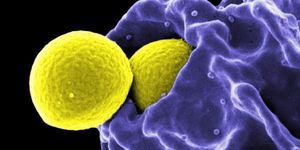A Better View of the Mechanisms Underlying Night Vision
When light levels are low, the rod cells of our eyes (specifically, the retina) go to work to help us see. While some of the specific biochemical pathways in rods are known, researchers have now learned more about a novel one. This work, which was reported in the Proceedings of the National Academy of Sciences (PNAS), involves a molecule called protein kinase A (PKA), a protein with a variety of important biological functions. The study authors engineered a mouse model in which a fluorescent signal changes when PKA is activated.
"PKA is found in many cells and is involved in a wide variety of biological processes. It's natural that researchers would find a way to observe its activities," noted the first author of the study Shinya Sato of the University of Kyoto Graduate School of Biostudies. "PKAchu mice were developed in 2012 -- 'chu' being Japanese for 'squeak'-- to allow us to closely monitor how PKA acts during specific biological processes. I decided to apply this to my work in retina biology."
The researchers also devised a method for capturing high-resolution images of live retinal tissue at high magnification. Combined with the mouse model, they could study how light stimulation altered PKA in the retina; they expected that light exposure would deactivate PKA. However, they were surprised to see the opposite effect.
"We started with a six-second illumination of the tissue. Incredibly, this activated PKA in the selected area for nearly fifteen minutes," revealed Sato. "We then did a ten-minute illumination, during which PKA was inactive. But when the lights were turned off, PKA kicked into gear. It was as if the darkness had activated it."
An analysis of individual cells showed that PKA was only activated in rod cells when the lights were turned off. Rod cells are crucial to night vision. Sato suggested that this may be a way for the eyes to boost their sensitivity to light in low light conditions, enhancing night vision; this activation of PKA seems to only happen in rod cells.
"We have not only uncovered many interesting aspects of retinal cells, but the further utility of PKAchu mice as well. We are excited to uncover the mechanisms and purpose behind these new findings, and perhaps illuminate our understanding of conditions such as night blindness," added the senior author of the study, Michiyuki Matsuda.
Sources: AAAS/Eurekalert! Via Kyoto University, PNAS



![WGS for rare disease diagnosis [eBook]](https://d3bkbkx82g74b8.cloudfront.net/eyJidWNrZXQiOiJsYWJyb290cy1pbWFnZXMiLCJrZXkiOiJjb250ZW50X2FydGljbGVfcHJvZmlsZV9pbWFnZV84MmRlM2UyYjA5M2Q3ZTYwOTI3Zjc1YTRjOWU2N2RmMjkzMThjMTJkXzI1MDcucG5nIiwiZWRpdHMiOnsidG9Gb3JtYXQiOiJqcGciLCJyZXNpemUiOnsid2lkdGgiOjcwMCwiaGVpZ2h0IjozNTAsImZpdCI6ImNvdmVyIiwicG9zaXRpb24iOiJjZW50ZXIiLCJiYWNrZ3JvdW5kIjoiI2ZmZiJ9LCJmbGF0dGVuIjp7ImJhY2tncm91bmQiOiIjZmZmIn19fQ==)




